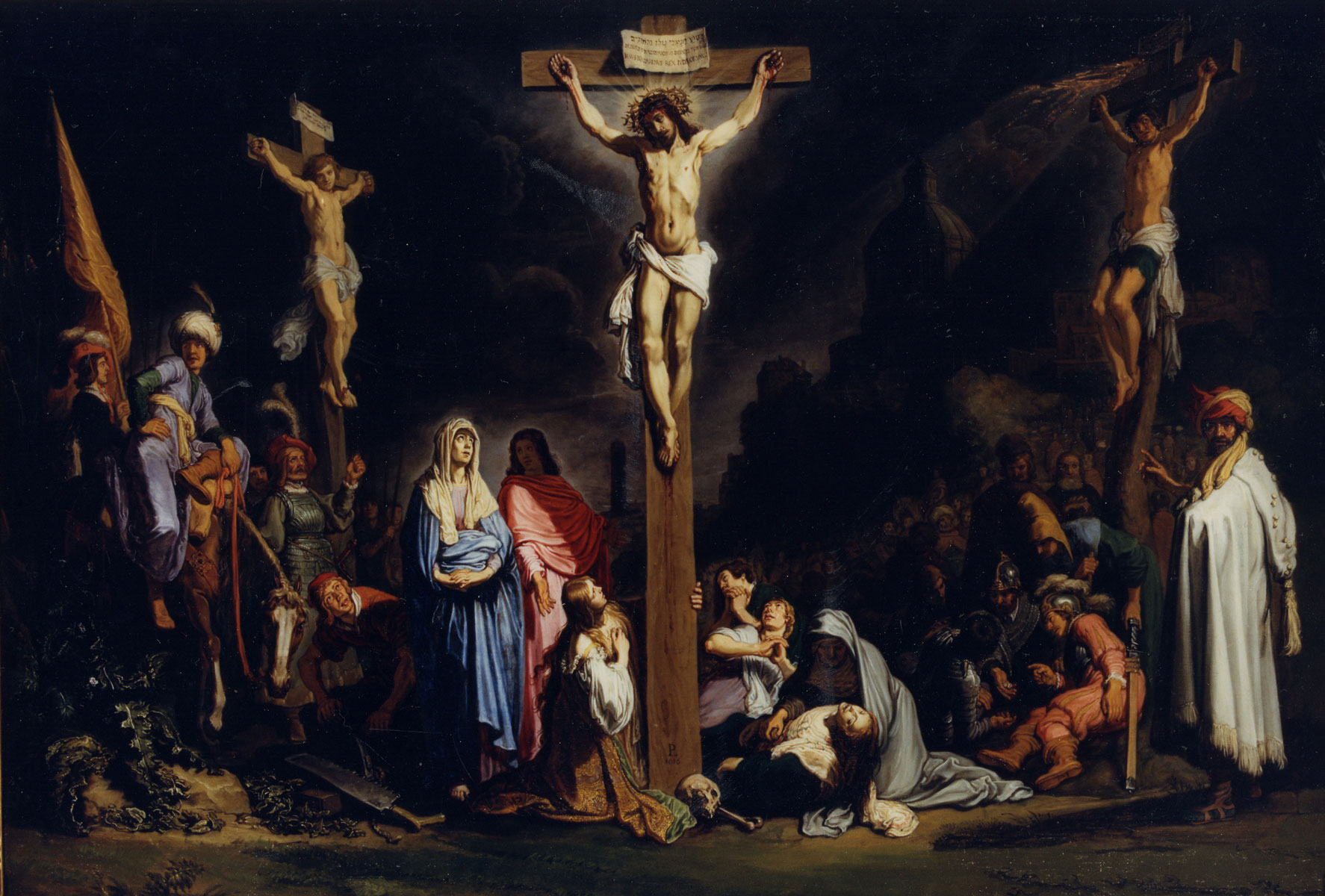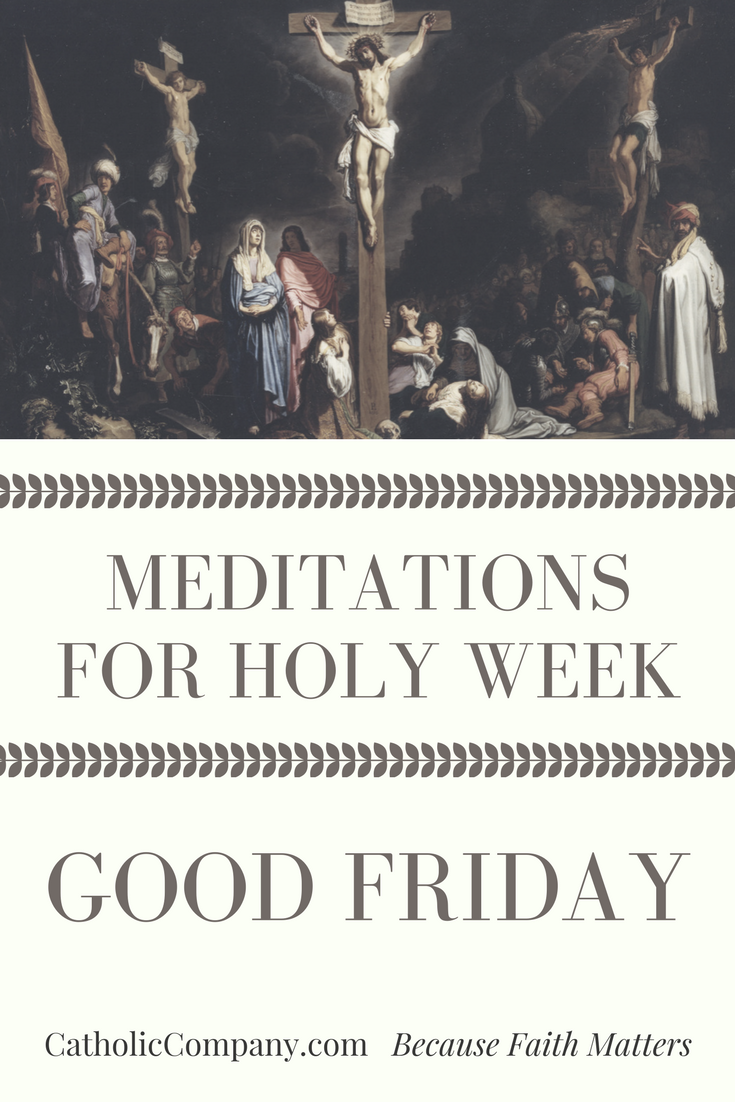Meditations for Holy Week: Good Friday
Mar 24, 2016 by Gretchen Filz
"But He was pierced for our offenses, crushed for our sins; upon him was the chastisement that makes us whole, by his stripes we were healed. We had all gone astray like sheep, each following his own way; but the Lord laid upon Him the guilt of us all."
—Isaiah 53:5-6
Since the altar was stripped bare and the Eucharist removed from the Tabernacle on Holy Thursday, in the past good Friday was sometimes called "Long Friday." The church is empty of His Eucharistic presence and we again feel a sense of waiting.
One of the most beautiful traditions of this day is the Veneration of the Cross. "While we bend down in body before the cross we bend down in spirit before God." If possible, try to pray the Stations of the Cross at 3 p.m. Many parishes also begin the Divine Mercy Novena on this day.
As we reflect on the Gospel account of Christ's Passion and death, let us try to keep an awareness in our hearts throughout this day of Our Lord's sufferings on our behalf.
GOSPEL READING FOR GOOD FRIDAY
The Crucifixion of Jesus
So they took Jesus; and carrying the cross by himself, he went out to what is called The Place of the Skull, which in Hebrew[m] is called Golgotha. There they crucified him, and with him two others, one on either side, with Jesus between them. Pilate also had an inscription written and put on the cross. It read, “Jesus of Nazareth, the King of the Jews.” Many of the Jews read this inscription, because the place where Jesus was crucified was near the city; and it was written in Hebrew, in Latin, and in Greek. Then the chief priests of the Jews said to Pilate, “Do not write, ‘The King of the Jews,’ but, ‘This man said, I am King of the Jews.’” Pilate answered, “What I have written I have written.”
When the soldiers had crucified Jesus, they took his clothes and divided them into four parts, one for each soldier. They also took his tunic; now the tunic was seamless, woven in one piece from the top. So they said to one another, “Let us not tear it, but cast lots for it to see who will get it.” This was to fulfill what the scripture says,
“They divided my clothes among themselves,
and for my clothing they cast lots.”
And that is what the soldiers did. Meanwhile, standing near the cross of Jesus were his mother, and his mother’s sister, Mary the wife of Clopas, and Mary Magdalene. When Jesus saw his mother and the disciple whom he loved standing beside her, he said to his mother, “Woman, here is your son.” Then he said to the disciple, “Here is your mother.” And from that hour the disciple took her into his own home.
After this, when Jesus knew that all was now finished, he said (in order to fulfill the scripture), “I am thirsty.” A jar full of sour wine was standing there. So they put a sponge full of the wine on a branch of hyssop and held it to his mouth. When Jesus had received the wine, he said, “It is finished.” Then he bowed his head and gave up his spirit.
Jesus’ Side Is Pierced
Since it was the day of Preparation, the Jews did not want the bodies left on the cross during the sabbath, especially because that sabbath was a day of great solemnity. So they asked Pilate to have the legs of the crucified men broken and the bodies removed. Then the soldiers came and broke the legs of the first and of the other who had been crucified with him. But when they came to Jesus and saw that he was already dead, they did not break his legs.
Instead, one of the soldiers pierced his side with a spear, and at once blood and water came out. (He who saw this has testified so that you also may believe. His testimony is true, and he knows that he tells the truth.) These things occurred so that the scripture might be fulfilled, “None of his bones shall be broken.” And again another passage of scripture says, “They will look on the one whom they have pierced.”

PASSION MEDITATION FROM ST. ALPHONSUS LIGUORI
Oh, how exceedingly tender, loving, and constraining was that declaration of our Blessed Redeemer concerning his coming into the world, when he said that he had come to kindle in souls the fire of divine love, and that his only desire was that this holy flame should be enkindled in the hearts of men: I am come to cast fire upon the earth; and what will I but that it should be kindled? He continued immediately to say that he was expecting to be baptized with the baptism of his own blood—not, indeed, to wash out his own sins, since he was incapable of sinning, but to wash out our sins, which he had come to satisfy by his sufferings: ‘The Passion of Christ is called baptism, because we are purified in his blood.’
And therefore our loving Jesus, in order to make us understand how ardent was his desire to die for us, added, with sweetest expression of his love, that he felt an immense longing for the time of his Passion, so great was his desire to suffer for our sake. These are his loving words: I have a baptism wherewith I am to be baptized; and how am I straitened until it be accomplished?
 _________________
_________________
This article has been updated. It was first published in April 2012. © The Catholic Company. All rights reserved.





